MaryAnn Bernal's Blog, page 210
December 18, 2014
Egypt cemetery is home to a million 'mummies'

A stray dog is seen at an archaeological site in Egypt this year. (AP Photo/Amr Nabil)
By Matt Cantor
Fox News
For the past 30 years, scientists have been exploring a cemetery in Egypt whose origins are mysterious. One thing they have determined, however: "We are fairly certain we have over a million burials within this cemetery. It's large, and it's dense," says the project's director, Kerry Muhlestein of Brigham Young University.
Dubbed Fag el-Gamous, the grounds are full of bodies that date to between the 1st and 7th centuries AD, Live Science reports. The remains don't belong to royalty, and most weren't actively mummified by people—but the dry surroundings led to what could "loosely" be called mummies, says Muhlestein, who has blogged about the findings.
Brigham Young researchers have dug up more than 1,700 burials over the past three decades, they write in Studia Antiqua, noting that they're not the first researchers to investigate the site.Among recent findings are the remains of an 18-month-old from about 1,500 years ago. "There was some evidence that they tried much of the full mummification process. The toes and toenails and brain and tongue were amazingly preserved," researchers say.
As for where the child, or countless others, came from, researchers aren't sure. Interestingly, a database reveals that blond people appear to have been buried together, with red-headed ones elsewhere; this could be due to families being buried together, researchers note.
They also found one body that was more than seven feet tall—particularly surprising given poor nutrition at the time. (Perhaps they should alert this giant hunter.)
This article originally appeared on Newser: Egypt Cemetery Holds 1M Mummies

Published on December 18, 2014 07:42
Archaeologists unearth 8,000-year-old olive oil remains in Israel
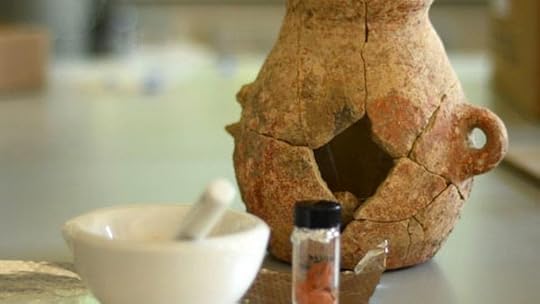 Some of the reconstructed 8,000-year-old jar shards found by the Israel Antiquities Authority in the Lower Galilee, Israel. (Israel Antiquities Authority)
Some of the reconstructed 8,000-year-old jar shards found by the Israel Antiquities Authority in the Lower Galilee, Israel. (Israel Antiquities Authority)Fox News
In what could be called a Hanukkah miracle, researchers from the Israel Antiquities Authority have discovered what they believe to be evidence of the earliest use of olive oil in not just Israel, but possibly the entire Middle East. An archaeological salvage excavation between 2011 and 2013 led by Ianir Milevski and Nimrod Getzov in the Lower Galilee – a region in northern Israel — unearthed 8,000-year-old remains of olive oil, according to a release from the Israel Antiquities Authority.
The excavation took place in the ‘En Zippori area in the Lower Galilee before the widening of Highway 79, which cuts through the region. The research team took samples from pieces of pottery at the site. With the help of Dvory Namdar at the Hebrew University of Jerusalem Institute of Earth and Science, the team conducted chemical tests on the objects to determine what “organic remains” were still “absorbed in the sides of the vessel.”
The pottery was found to contain olive oil that dated back to the Bronze Age. The organic material was compared to samples of modern-day, one-year-old olive oil.
Out of 20 items that were sampled, two were especially ancient, dating back to about 5,800 B.C.
The team’s announcement is certainly seasonally appropriate, taking place at the start of Hanukkah, the Jewish holiday that commemorates the re-dedication of Jerusalem’s Holy Temple during the second-century B.C. The story of Hanukkah describes the olive oil being used to light a menorah at the temple that shined brightly for eight days.
Despite the significance of the find to Jewish culture, the community that actually used the olive oil was actually pre-Jewish, Milevski told The Times of Israel.
“We have no writing during that period so we know little about them,” he said. “We do not know what language they spoke but we assume it was an early Semitic language, from which Babylonian and Akkadian evolved and later also Hebrew and Arabic.”

Published on December 18, 2014 07:36
M. C. Arvanitis, writer / WORDS TOGETHER MAKE TALES: World War 2 novel coming in 2015
M. C. Arvanitis, writer / WORDS TOGETHER MAKE TALES: World War 2 novel coming in 2015 - by M. C. Arvani...: ANNOUNCING! Author, M.C. Arvanitis’s next novel in her YA historical books W...
World War 2 novel coming in 2015 - by M. C. Arvanitis
ANNOUNCING!Author, M.C. Arvanitis’s next novel in her YA historical books
Writing a book is like birthing a baby---both are held close to the heart until they are ready to be born, but a book starts in the mind instead of the womb---it is conceived as an idea first, then developed into a plausible shape until it is ready to be born---and somewhere along the line it gets a title.
EMMA ROSE’S WAR

'Emma Rose's War' takes the reader back to the time of WW2, into the Midwest rural community, and how it affects the life of a teenage farm girl whose family is of German ancestry.
From the time she could write, Emma Rose has written down all her thoughts in her diaries. She dreams of being a reporter, like 'Brenda Star, the redheaded comic heroine taken from a comic series, ‘Brenda Star, Girl Reporter’. Emma Rose hates being a girl and determines not to grow up to do what every other farm girl does; get married to a farmer right after high school and have a pack of kids. Her fear of growing up creates another war in her mind. She swears to never fall in love with a farmer...But would her heart betray her?
Emma Rose hates being a girl and determines not to grow up to do what every other farm girl does; get married to a farmer right after high school and have a pack of kids. Her fear of growing up creates another war in her mind. She swears to never fall in love with a farmer...But would her heart betray her?
She misses her beloved brother, Tobias, who had been one of the first to join the US Navy to escape being drafted into the Army.

 His ship is lost at the disastrous bombing of Pearl Harbor, which started WW 2. And he is now missing in action.
His ship is lost at the disastrous bombing of Pearl Harbor, which started WW 2. And he is now missing in action.
Read More
World War 2 novel coming in 2015 - by M. C. Arvanitis
ANNOUNCING!Author, M.C. Arvanitis’s next novel in her YA historical books

Writing a book is like birthing a baby---both are held close to the heart until they are ready to be born, but a book starts in the mind instead of the womb---it is conceived as an idea first, then developed into a plausible shape until it is ready to be born---and somewhere along the line it gets a title.
EMMA ROSE’S WAR

'Emma Rose's War' takes the reader back to the time of WW2, into the Midwest rural community, and how it affects the life of a teenage farm girl whose family is of German ancestry.
From the time she could write, Emma Rose has written down all her thoughts in her diaries. She dreams of being a reporter, like 'Brenda Star, the redheaded comic heroine taken from a comic series, ‘Brenda Star, Girl Reporter’.
 Emma Rose hates being a girl and determines not to grow up to do what every other farm girl does; get married to a farmer right after high school and have a pack of kids. Her fear of growing up creates another war in her mind. She swears to never fall in love with a farmer...But would her heart betray her?
Emma Rose hates being a girl and determines not to grow up to do what every other farm girl does; get married to a farmer right after high school and have a pack of kids. Her fear of growing up creates another war in her mind. She swears to never fall in love with a farmer...But would her heart betray her?She misses her beloved brother, Tobias, who had been one of the first to join the US Navy to escape being drafted into the Army.

 His ship is lost at the disastrous bombing of Pearl Harbor, which started WW 2. And he is now missing in action.
His ship is lost at the disastrous bombing of Pearl Harbor, which started WW 2. And he is now missing in action. Read More

Published on December 18, 2014 06:43
Chistmas shopping? Paperback edition of Scribbler Tales (volume two) now available
 Madeline’s personal feelings clouds her judgment in Broken Promises where she must choose between love and obeying the law. When the guilty walk, a vigilante executes the criminals in Deception. Endgame finds a government researcher running for her life after discovering a horrific CIA secret in the isolated facility. A modern day Don Juan’s life is turned upside down in Malice when he is falsely accused of rape. In The Portrait, Holliday is obsessed with a formidable ancestor whose spirit wishes to possess her soul.
Madeline’s personal feelings clouds her judgment in Broken Promises where she must choose between love and obeying the law. When the guilty walk, a vigilante executes the criminals in Deception. Endgame finds a government researcher running for her life after discovering a horrific CIA secret in the isolated facility. A modern day Don Juan’s life is turned upside down in Malice when he is falsely accused of rape. In The Portrait, Holliday is obsessed with a formidable ancestor whose spirit wishes to possess her soul.

Kindle
Paperback


Published on December 18, 2014 05:00
History Trivia - Hannibal's Carthaginian forces defeats Roman forces
December 18
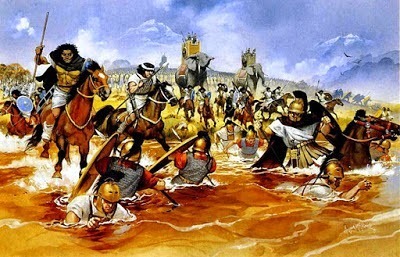
218 BC Second Punic War: Battle of the Trebbia – Hannibal's Carthaginian forces defeated those of the Roman Republic.

1118 Afonso the Battler, the Christian King of Aragon captured Saragossa, Spain, causing a major blow to Muslim Spain.

1352 Innocent VI became Pope. He introduced many needed reforms in the administration of church affairs and also sought to restore order in Rome, where, in 1355, Charles IV (1346–78) was crowned Holy Roman Emperor with his permission, after previously having made an oath that he would quit the city on the day of the ceremony.


218 BC Second Punic War: Battle of the Trebbia – Hannibal's Carthaginian forces defeated those of the Roman Republic.

1118 Afonso the Battler, the Christian King of Aragon captured Saragossa, Spain, causing a major blow to Muslim Spain.

1352 Innocent VI became Pope. He introduced many needed reforms in the administration of church affairs and also sought to restore order in Rome, where, in 1355, Charles IV (1346–78) was crowned Holy Roman Emperor with his permission, after previously having made an oath that he would quit the city on the day of the ceremony.

Published on December 18, 2014 03:00
December 17, 2014
Season's Greetings from Mary Ann Bernal and Whispering Legends Press

Whispering Legends Press featured author Mary Ann Bernal Whispering Legends Press
Wishing everyone a blessed holiday season.
I am grateful for your support and interest in my work.
God bless.
Mary Ann Bernal


Published on December 17, 2014 16:55
Hanukkah began at sunset Tuesday, December 16, 2014 and ends at nightfall Wednesday, December 24, 2014 (in 7 days).

Hanukkah (Chanukkah) is a Jewish holiday celebrated for eight days and nights. It starts on the 25th of the Jewish month of Kislev, which coincides with late November-late December on the secular calendar.
The Hanukkah StoryIn 168 B.C.E. the Jewish Temple was seized by Syrian-Greek soldiers and dedicated to the worship of the god Zeus. This upset the Jewish people, but many were afraid to fight back for fear of reprisals. Then in 167 B.C.E. the Syrian-Greek emperor Antiochus made the observance of Judaism an offense punishable by death. He also ordered all Jews to worship Greek gods.
Jewish resistance began in the village of Modiin, near Jerusalem. Greek soldiers forcibly gathered the Jewish villages and told them to bow down to an idol, then eat the flesh of a pig – both practices that are forbidden to Jews. A Greek officer ordered Mattathias, a High Priest, to acquiesce to their demands, but Mattathias refused. When another villager stepped forward and offered to cooperate on Mattathias' behalf, the High Priest became outraged. He drew his sword and killed the villager, then turned on the Greek officer and killed him too. His five sons and the other villagers then attacked the remaining soldiers, killing all of them.
Mattathias and his family went into hiding in the mountains, where other Jews wishing to fight against the Greeks joined them. Eventually they succeeded in retaking their land from the Greeks. These rebels became known as the Maccabees, or Hasmoneans.
Once the Maccabees had regained control they returned to the Temple in Jerusalem. By this time it had been spiritually defiled by being used for the worship of foreign gods and also by practices such as sacrificing swine. Jewish troops were determined to purify the Temple by burning ritual oil in the Temple’s menorah for eight days. But to their dismay, they discovered that there was only one day's worth of oil left in the Temple. They lit the menorah anyway and to their surprise the small amount of oil lasted the full eight days.
This is the miracle of the Hanukkah oil that is celebrated every year when Jews light a special menorah known as a hanukkiyah for eight days. One candle is lit on the first night of Hanukkah, two on the second, and so on, until eight candles are lit. You can learn more about the hanukkiyah in the article: What Is a Hanukkiyah?
Read More
By Ariela Pelaia

Published on December 17, 2014 08:06
Ancient Farmhouse Found in Israel Reveals Agricultural Secrets
by Laura Geggel
Live Science
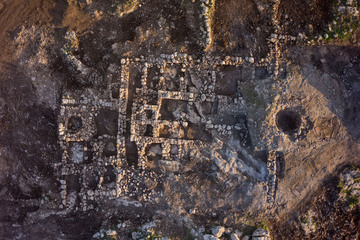
A bird's-eye view of the 23-room farmhouse from the eighth century B.C.
Credit: Skyview Company, courtesy of the Israel Antiquities Authority
An ancient farmhouse dating back to 2,800 years ago — complete with 23 rooms, winepresses and a grain silo — is no longer lost to the ages. Over the past few weeks, archaeologists have uncovered the sprawling stone house in Rosh Ha-'Ayin, in central Israel.
Archaeologists found the farmhouse during an excavation that the government required be done before construction could begin to enlarge the modern city. The house, which measures 98 by 131 feet (30 by 40 meters), is "extraordinarily well preserved," Amit Shadman, excavation director on behalf of the Israel Antiquities Authority, said in a statement.
The farmhouse dates back to the time of the Assyrian conquest, when the Assyrians conquered Northern Israel, the researchers said. [The Holy Land: 7 Amazing Archaeological Finds]
Farmhouses during this period served as small settlements of sorts, whose inhabitants participated in processing agricultural produce," Shadman said. "The numerous winepresses discovered in the vicinity of the settlement indicate the wine industry was the most important branch of agriculture in the region."
The large silo found at the farmhouse likely stored grain, which "shows that the ancient residents were also engaged in growing cereal," Shadman said.This isn't the first time archaeologists in Israel have stumbled across ancient winepresses. In September, a team uncovered an industrial-size winepress outside Jerusalem in what was likely a monastery before the 7th century B.C., and in 2013, archaeologists found a 1,500-year-old winepress under a city street in Tel Aviv.
Ancient people continued using the building during the period of the 6th century B.C. called The Return to Zion, when the Jewish people returned to Israel after the Babylonian exile. The building remained active later, during the Hellenistic period that followed in the wake of Alexander the Great's military conquests.
After Alexander's army defeated the Persians in 333 B.C., he built an empire that spanned from Greece to present-day Pakistan. The people of Israel welcomed the leader, Shadman said.
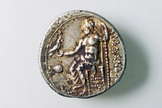
[image error] The reverse side of the coin has an image of Zeus and an inscription of Alexander the Great's name.
Credit: Robert Kool, courtesy of the Israel Antiquities Authority
View full size imageIn the farmhouse, the archaeologists also found an object that suggests a Greek presence during that era: a rare silver coin with an image of Zeus and Alexander's name next to it — spelled ΑΛΕΞΑNΔΡΟΥ — on one side, and the head of Heracles (often called "Hercules," the Romanized name for the Greek mythological hero known for his extraordinary strength) on the reverse side.
The Israel Antiquities Authority and the Ministry of Construction plan to preserve the farmhouse and open it to the public, the researchers said.After Alexander's generals divided the empire following his death, the farmhouse remained useful for centuries. During the Ottoman period, which lasted from 1299 to 1923, people used the stones in the building as a source of raw materials, Shadman said.
Live Science

A bird's-eye view of the 23-room farmhouse from the eighth century B.C.
Credit: Skyview Company, courtesy of the Israel Antiquities Authority
An ancient farmhouse dating back to 2,800 years ago — complete with 23 rooms, winepresses and a grain silo — is no longer lost to the ages. Over the past few weeks, archaeologists have uncovered the sprawling stone house in Rosh Ha-'Ayin, in central Israel.
Archaeologists found the farmhouse during an excavation that the government required be done before construction could begin to enlarge the modern city. The house, which measures 98 by 131 feet (30 by 40 meters), is "extraordinarily well preserved," Amit Shadman, excavation director on behalf of the Israel Antiquities Authority, said in a statement.
The farmhouse dates back to the time of the Assyrian conquest, when the Assyrians conquered Northern Israel, the researchers said. [The Holy Land: 7 Amazing Archaeological Finds]
Farmhouses during this period served as small settlements of sorts, whose inhabitants participated in processing agricultural produce," Shadman said. "The numerous winepresses discovered in the vicinity of the settlement indicate the wine industry was the most important branch of agriculture in the region."
The large silo found at the farmhouse likely stored grain, which "shows that the ancient residents were also engaged in growing cereal," Shadman said.This isn't the first time archaeologists in Israel have stumbled across ancient winepresses. In September, a team uncovered an industrial-size winepress outside Jerusalem in what was likely a monastery before the 7th century B.C., and in 2013, archaeologists found a 1,500-year-old winepress under a city street in Tel Aviv.
Ancient people continued using the building during the period of the 6th century B.C. called The Return to Zion, when the Jewish people returned to Israel after the Babylonian exile. The building remained active later, during the Hellenistic period that followed in the wake of Alexander the Great's military conquests.
After Alexander's army defeated the Persians in 333 B.C., he built an empire that spanned from Greece to present-day Pakistan. The people of Israel welcomed the leader, Shadman said.

[image error] The reverse side of the coin has an image of Zeus and an inscription of Alexander the Great's name.
Credit: Robert Kool, courtesy of the Israel Antiquities Authority
View full size imageIn the farmhouse, the archaeologists also found an object that suggests a Greek presence during that era: a rare silver coin with an image of Zeus and Alexander's name next to it — spelled ΑΛΕΞΑNΔΡΟΥ — on one side, and the head of Heracles (often called "Hercules," the Romanized name for the Greek mythological hero known for his extraordinary strength) on the reverse side.
The Israel Antiquities Authority and the Ministry of Construction plan to preserve the farmhouse and open it to the public, the researchers said.After Alexander's generals divided the empire following his death, the farmhouse remained useful for centuries. During the Ottoman period, which lasted from 1299 to 1923, people used the stones in the building as a source of raw materials, Shadman said.

Published on December 17, 2014 07:46
Diane Turner London Rocks - 15-12-2014
Published on December 17, 2014 06:19
History Trivia - Ostrogoths of King Totila conquer Rome
December 17,

546 Gothic War: The Ostrogoths of King Totila conquered Rome by bribing the Byzantine garrison.
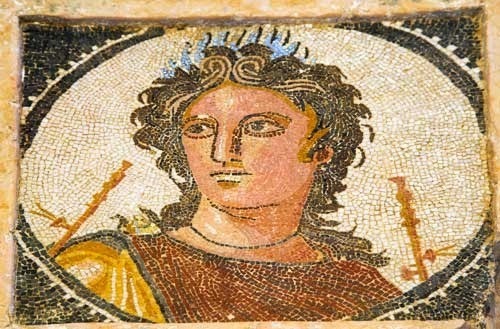
920 Romanos I was crowned co-emperor of the underage Emperor Constantine VII.

1187 Pope Gregory VIII died. In his brief pontificate, Gregory initiated the Third Crusade and began reforms in the Curia.

1531 Pope Clement VII established a parallel body to the Inquisition in Lisbon, Portugal.


1538 Pope Paul III excommunicated Henry VIII of England.


546 Gothic War: The Ostrogoths of King Totila conquered Rome by bribing the Byzantine garrison.

920 Romanos I was crowned co-emperor of the underage Emperor Constantine VII.

1187 Pope Gregory VIII died. In his brief pontificate, Gregory initiated the Third Crusade and began reforms in the Curia.

1531 Pope Clement VII established a parallel body to the Inquisition in Lisbon, Portugal.


1538 Pope Paul III excommunicated Henry VIII of England.

Published on December 17, 2014 03:30




